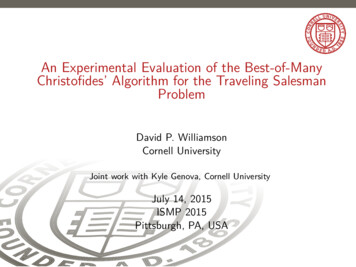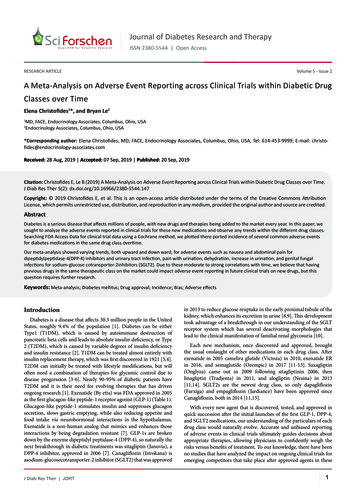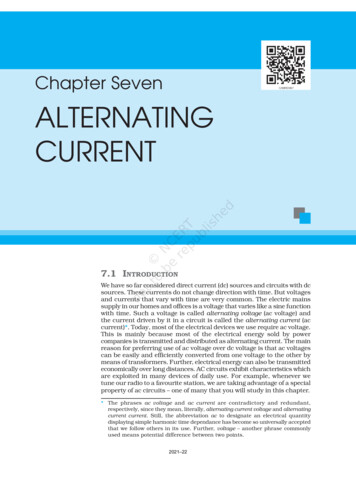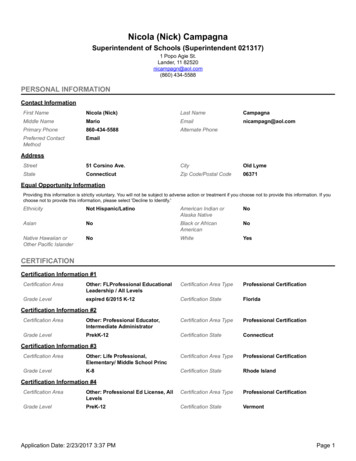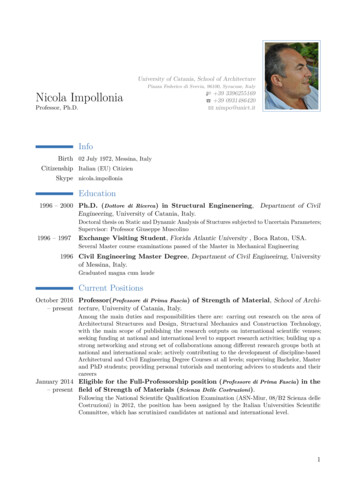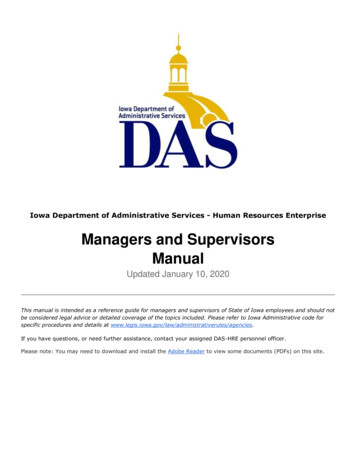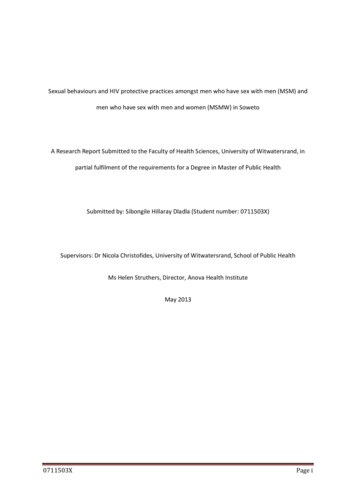
Transcription
Sexual behaviours and HIV protective practices amongst men who have sex with men (MSM) andmen who have sex with men and women (MSMW) in SowetoA Research Report Submitted to the Faculty of Health Sciences, University of Witwatersrand, inpartial fulfilment of the requirements for a Degree in Master of Public HealthSubmitted by: Sibongile Hillaray Dladla (Student number: 0711503X)Supervisors: Dr Nicola Christofides, University of Witwatersrand, School of Public HealthMs Helen Struthers, Director, Anova Health InstituteMay 20130711503XPage i
DeclarationI, Sibongile Dladla, declare that this research is my own work. It is submitted in partial fulfilment ofthe degree of Master in Public Health in the field of Health Systems and Policy, at theWitwatersrand, Johannesburg. This research has not been submitted for any examination or degreeat this or any other university. .May 20130711503XPage ii
AcknowledgementsI would like to extend my appreciation and thanks to Dr Nicola Christofides who supervised methrough this task, without your encouragements and facilitation, I would not have done this workeffectively.Special thanks to Anova Health Institute directors for their patience in me and for allowing me to usetheir information and participants who attend the Health4men Clinic.Big thanks to my son who has been waiting patiently for this time to come so we can spend timetogether. Also would thank my mother who has been supporting me throughout my studies withoutyour support none of this would be achieved.0711503XPage iii
AbstractBackground: there is a growing body of research on men who have sex with men (MSM) and riskfactors for HIV in South Africa. However, in order to develop more appropriate and relevantinterventions to reduce the transmission of HIV amongst MSM and MSMW, there was a need todeepen our understanding of sexual risk behaviour and protective practices. The aim of the studywas to explore the sexual risk and protective behaviour of men who have sex with men and womenin Soweto, South Africa.Methods: In-depth interviews were conducted with twelve men who self-identified as MSM fromthe Health4men clinic, a men’s clinic situated at the Perinatal HIV Research Unit, Chris HaniBaragwanath Hospital. The interviews were conducted by the researcher in the counselling room toensure privacy and confidentiality was assured. The interviews were taped, transcribed verbatim andthematic analysis conducted.Results: The study found that the 10 gay-identified and two bisexual-identified men had knowledgeon HIV transmission and how to protect themselves from infection but having knowledge did notnecessary translate to consistent safer sex practices. High partner numbers and concurrency weredescribed by study participants. Condoms were used but not consistently with different partners.Alcohol abuse played a critical role in engaging in sex with once-off partners, often with usingcondoms. Participants reflected on the lack of HIV prevention messaging that addressed their lives.Conclusion: The study found that gay and bisexual men in Soweto are vulnerable to HIV as there areno sufficient prevention effort put into their health by the government and other stakeholders. HIVrelated stigma, alcohol use, partner numbers and homophobia were perceived to contribute to HIVprevalence. Behaviour-change strategies, embedded in broader social change, remain an importantHIV prevention strategy in the MSM community.0711503XPage iv
Table of contentsDeclaration .iiAcknowledgements .iiiAbstract .ivTable of contents .vAcronyms .viiiDefinition of key terms .ixChapter 1: Background and Introduction1.1 Introduction .11.2 Statement of the problem .21.3 Justification 21.4 Aims and objectives . 3Chapter 2: Literature review2.1 The extent of HIV in South Africa .42.2 HIV and MSM Global perspective .52.3 HIV and MSM in South Africa 62.4 HIV Risk Factors among MSM .72.4.1 Unprotected anal sex .72.4.2 Condom use .82.4.3 Partner numbers .82.4.4 Concurrency .92.4.5 Risk and Protective behaviour .92.4.6 HIV, Alcohol and Drug use .100711503XPage v
2.4.7 HIV knowledge .112.4.8 Perception of Risk among MSM 112.4.9 Homophobia 122.4.10 HIV Protective Factors amongst MSM . 12Chapter 3: Methodology3.1 Study design 143.2 Study site 143.3 Study population .143.4 Study sample .143.5 Data collection .153.6 Data management and Analysis 163.7 Ethical considerations .17Chapter 4: Findings .184.1 Perceptions of HIV and HIV risk .184.2 HIV knowledge and transmission .204.3 Non-disclosure of HIV status .214.4 Multiple and concurrent partners 224.5 Partner numbers .234.6 Where sex takes place. .234.7 Condom use with different sexual partners .254.8 Alcohol use & sexual risk behaviour .274.9 Homonegativity and discrimination .284.10 Perceptions of HIV messages .300711503XPage vi
Chapter 5: Discussion 335.1 Knowledge of HIV & risk perception .335.2 Sexual behaviour, risk and protective practices .345.3 Awareness of HIV prevention campaigns and keymessages .355.4 Homonegativity &discrimination .365.5 Limitations .37Chapter 6: Conclusion and Recommendations6.1 Conclusion .396.2 Recommendations .396.2.1 Venue .416.2.2 Homonegativity . .426.2.3 HIV messages . 43References . .44Appendix A .460711503XPage vii
AcronymsAIDS:Acquired Immune Deficiency SyndromeART:Anti-Retroviral TreatmentMSM:Men who have sex with menMSMW:Men who have sex with both men and womenHIV:Human Immunodeficiency VirusNSP:National Strategic PlanSTI:Sexually Transmitted InfectionVCT:Voluntary HIV Counselling and TestingUAI:Unprotected Anal Intercourse0711503XPage viii
Definition of key termsMSM:Men who have sex with men (MSM): is an abbreviation used for Men who have sex withmen or males who have sex with males. The term describes males who have sex with males,regardless of whether or not they have sex with women or have personal or social gay orbisexual identity (UNAIDS., 2011).Gay:The term gay can refer to same-sex sexual attraction, same-sex sexual behaviour, and samesex cultural identity. The expression ‘men who have sex with men’ should be used unlessindividuals or groups self-identify as gay (UNAIDS., 2011).Bisexual:Bisexual is defined as a person who is attracted to and/or has sex with both men andwomen and who identifies with this as a cultural identity. The expression ‘men who havesex with both men and women’ or ‘women who have sex with both women and men’should be used unless individuals or groups self-identify as “bisexual” (UNAIDS., 2011).Heterosexual:An individual who is attracted emotionally and physically to people of the oppositesex/gender. Heterosexuals do not necessarily have to have sexual experiences with peopleof the other sex/gender in order to identify themselves as being heterosexual (UNAIDS.,2011).Homosexual:An individual who is attracted sexually, emotionally and affectionately to people of thesame sex/gender (UNAIDS., 2011).Homophobia:0711503XPage ix
Has been an umbrella concept used to describe a varied range of social phenomena relatedwith prejudice, discrimination and violence against homosexuals (UNAIDS., 2010).Internalised homophobia:Reflects a lack of positive beliefs about being gay, about valuation of large gay community,and about the morality of being gay (Steven., 2009).Safer sex:The term ‘safer sex’ reflects the idea that choices can be made and behaviours adopted toreduce or minimize the risk of HIV transmission, these include consistent and correctcondom use for vaginal or anal intercourse (UNAIDS., 2011).Sexual orientation:The term ‘sexual orientation’ refers to each person’s profound emotional and sexualattraction to, and intimate and sexual relations with, individuals of different, the same, orboth sexes (UNAIDS., 2011).Sexual health:WHO describes sexual health as part of one’s mental and physical health. It is defined as:‘the integration of the somatic, emotional, intellectual and social aspects of sexual being, inways that are positively enriching and that enhances personality, communication and love’(WHO., 1995).0711503XPage x
Chapter 1: Introduction1.1 IntroductionSince the beginning of the HIV/AIDS pandemic in the 1980s, almost 60 million people havebeen infected and 25 million people have died of HIV related causes (UNAIDS., 2009). In theUNAIDS report on the Global AIDS Epidemic ( 2010) it is reported that in 2009, there wereestimated 2.6 people who became newly infected with HIV. In 33 countries, the HIVincidence has fallen by more than 25% between 2001 and 2009. Of these, 22, are from thesub-Saharan Africa (UNAIDS., 2010).Sex between men was identified as a significant route of HIV transmission in the 1980s(UNAIDS., 2008). Sex between men happens in every part of the world, in all societies andbetween men of all ages and there is a worldwide misconception that sex between menoccurs only among men who self-identify as gay (UNAIDS., 2006).Globally, less than one of 20 men who have sex with men (MSM) has access to HIVprevention and care (UNAIDS., 2006). This is evident in much of the developing world and inAfrica in particular where the stigmatisation, discrimination, and criminalisation ofhomosexuality persist (UNAIDS., 2006). In Africa, recent studies reported that 25% of MSMin coastal Kenya and 22% in Dakar, Senegal are HIV positive (UNAIDS., 2006). In South Africa,recent evidence suggests that HIV prevalence among MSM may be even higher withestimates between 14.7% and 36.6% (Lane., Fisher., et al 2009; Rispel & Metcalf., 2009).Other studies in Africa documented high proportions of MSM reporting recent sexualrelationships with women and bisexual men, indicating that the sexual networks of MSMextended to the general population (Population Council., 2009).In the generalised HIV epidemic and high-prevalence zone of southern sub-Saharan Africa,there is little evidence of the epidemic control especially amongst MSM (Beyrer., 2010).While southern sub-Saharan Africa has long been the most HIV/AIDS affected regionglobally, it has been arguably the most understudied for the risks of HIV associated withmale to male sexual contact (Baral., et al 2006). The highest rates of HIV infection overallreported by various studies have been seen in sub-Saharan Africa where heterosexualintercourse is the main transmission path for the spread of HIV (Baral., et al, 2006). The0711503XPage 1
studies report that African MSM’s are at risk of HIV infection, and that they have beenmarkedly underserved and marginalised (Baral., et al 2006).1.2 Statement of the problemMSM from low and middle-income countries are in urgent need of prevention and care, andappear to be both understudied and underserved (UNAIDS., 2006). There is a large body ofknowledge from the United States about the prevalence and incidence of HIV and theassociated risk factors among MSM (Herrick., et al 2011, Jacobs., et al 2010, Nicole., et al2006). There is also growing evidence of the prevalence of HIV and sexual risk behaviours ofMSM and protective measures with different sexual partners in South Africa and inparticular among African MSM (Cacers., et al 2009, Kiene., et al 2006, Sandfort., et al 2008,Saharaj., et al 2008). In order to be able to address these challenges, more research and adeeper understanding is required to understand perceptions of risk among MSM.1.3 Justification for the studyMen who have sex with men and men who have sex with men and women (MSM & MSMW)are still hidden in most communities. Several studies across sub-Saharan Africa suggest thatunprotected anal sex between men is an important factor in the epidemic (Baral., et al2006). There is growing research from South Africa that describes the perceptions of HIVrisk and protective behaviour among men who have sex with men and women (MSMW).However, this research has not focused on how current HIV prevention messages mostlytargeting the heterosexual population are perceived by MSM and MSMW.This research will help fill gaps in information needed for monitoring of the NationalStrategic Plan on HIV, STIs & TB (NSP) 2012-2016, as well as help to provide information onHIV risk behaviours among MSM as part of the United General Assembly (UNGASS)monitoring requirements (NSP 2012-2016). Results from this study could help shapeprevention messages and programmes targeted towards MSM an MSMW.0711503XPage 2
1.4 Aim and objectivesThe overall aim of this study was to explore the sexual risk and protective behaviour of menwho have sex with other men (and women) attending Health4Men services in Soweto,South Africa. The data were collected from September 2009 and ended in March 2010.The specific objectives were:1. To describe and analyse the perceptions of HIV risk among men who have sex with men,and men who have sex with men and women attending Health4Men services in Soweto forthe period September 2009 to October 2010.2. To explore the sexual risk behaviour and protective practices among MSM and MSMWincluding where and with whom men were having sex, condom use, lubrication use, alcoholand drug use.3. To describe awareness of HIV prevention campaigns and perceptions of key messagesamong MSM and MSMW.0711503XPage 3
Chapter 2: Literature review2.1 The extent of HIV in South AfricaSouth Africa is recognised as one of the countries most severely impacted by the HIV/AIDSpandemic (UNAIDS., 2006). An estimated 5.6 million people were living with HIV and AIDS inSouth Africa in 2011, the highest number of people in any country(UNAIDS., 2010).HIV infection levels differ substantially by age and sex and also show a very unevendistribution among the nine provinces (Shisana., et al 2008). The country is experiencing amaturing generalised HIV epidemic in which heterosexual sex is the predominant mode ofHIV transmission followed by mother-to-child transmission. Young adults, particularlyfemales, are at greatest risk of acquiring HIV. Almost one-in-three women aged 25-29, andover a quarter of men aged 30-34 are living with HIV in South Africa (Shisana., et al, 2008).New indications show a slowing HIV incidence amid some signs of shift towards safer se sexamong young people. The annual HIV incident among 18 year olds declined sharply from1.8% in 2005 to 0.8% in 2008, and among women 15–24 years old it dropped from 5.5% in2003–2005 to 2.2% in 2005–2008 (UNADIS., 2010)(4).According to the Shisana, et al (2009) South African HIV prevalence, incidence, behaviourand communication survey 2008, MSM are now categorized under the Most at RiskPopulation (MARPs). MARPs are defined as those populations that are found to have ahigher HIV prevalence when compared to the general population (UNAIDS., 2006). In thegeneralised epidemic of Southern African the definition of MARPs is not clear cut, as higherthan average prevalence may apply to large populations and sub-populations. Some MARPSare not necessarily stigmatised or marginalised to the same extent as others, it remains truethat their risks are higher (Shisana., et al., 2009). In HIV for example, there are groups that aremarginalised, i.e. men who have sex with men, commercial sex workers, truck drivers and manymore) who are excluded from policies benefiting the wider public – in some cases there are lawsagainst MSM. Other at-risk populations are often among the most marginalised and mostlikely to be stigmatised. In the National Strategic Plan on HIV, STIs and TB 2007-2011 thepoint is made that there is very little known about HIV prevalence and incidence among the0711503XPage 4
MSM population while noting that this population is particularly susceptible to HIV infection(Department of Health., 2007).2.2 HIV and MSM: Selected international literatureThe use of the term “MSM” has been used to describe the behaviour of biological maleshaving sex with other biological males, but that does not address issues of sexual andgender identity and how identity and behaviour interact (Caceres., et al. 2009).The Joint United Nations Programme on HIV/AIDS (UNAIDS) notes that faced with legal orsocial sanctions, men having sex with men are either excluded from, or exclude themselvesfrom, sexual health and welfare agencies because they fear being identified as homosexuals(UNAIDS.,2008). MSM who disclose their orientation, through choice or necessity, reportfamily rejection, public humiliation, harassment by authorities and ridicule by health careworkers (Smith., et al 2009) Unprotected anal intercourse is the primary risk factor for HIVinfection for MSM. Sex between men frequently involves anal intercourse, which ifunprotected, carries a high risk of HIV transmission for the receptive partner, and asignificant risk for the insertive partner (Magda., 2008). At least 5-10% of all infectionsworldwide are due to sexual transmission between men (UNAIDS., 2008).Sex between men occurs in every culture and society though the extent and publicacknowledgement vary from place to place (UNAIDS., 2008). In the USA, MSM continue tobe the group most impacted by the human immunodeficiency virus (HIV) epidemic (Robin.,Isabel., et al 2010). They account for nearly half of the approximately one million peopleliving with HIV in the USA and 53% of all new infections (CDC., 2009). A survey conducted inSenegal and Voluntary Counselling and Testing (VCT) data from Kenya, found that HIVprevalence for MSM was higher than the national prevalence estimates (Wade., 2005).Researches from recent studies in sub-Saharan Africa indicate the existence of groups ofmen who have sex with men and high levels of HIV infection among them. Up to 20% of newHIV infections in Senegal (23) and 15% of those in Kenya (20) and Rwanda (24) could belinked to unprotected sex between men (UNAIDS., 2010) Available evidence suggests that insub-Saharan Africa, as elsewhere in the world, the majority of men who have sex with menalso have sex with women (UNAIDS., 2010).0711503XPage 5
Several studies have been conducted in America that looked at the age and race at whichMSM become infected with HIV. One of the studies was conducted by CDC was a closedcohort study of young gay men at the age of 18, none of whom were infected at age 18, theincidence rate of infection was estimated to be 2.4% per year as these men moved from age20 to age 40 (CDC., 2008). Another study conducted by Centre for disease control (CDC), andpublished in June 2011 that investigated HIV and young MSM in the United States revealedsimilar findings as Lane and colleagues study from South Africa. They reported an estimated56,300 Americans are infected with HIV each year. Of these, 34% are adolescents or youngadults aged 13-19 years. Young MSM especially black MSM were at the highest risk (CDC.,2011).2.3 HIV and MSM in South AfricaHIV prevalence in the population of men who have sex with men in South Africa isconsistently higher than the general population (Lane., et al 2007). Lane and colleagues(2011) reported that the HIV prevalence among men who have sex with men in Soweto was13.2%. Rispel and colleagues found that HIV prevalence among MSM was 49.5% inJohannesburg and in Durban was 27.5% (Rispel., et al 2011).The study by Lane., et al (2011), found that HIV prevalence estimation amongst selfidentifying gay men is 33.9%, which is three times greater than that of bisexual and straightidentified MSM whose respective estimates were 6.4% and 10.6%. Baral (2006) reportedHIV rates, where available, have been higher than among other men of reproductive age inthe same populations. Several studies appear to confirm this, with rates between 14.1% and38.3% (Lane., et al 2011; Sandfordt, 2008).Recently published data from the Soweto Men’s study on HIV prevalence and riskbehaviours suggest that young gay and bisexual men continue to place themselves atconsiderable risk of infection with HIV and other sexually transmitted diseases (Lane., et al2011). The study confirmed that HIV prevalence among self-identifying gay men to be threetimes greater than that of straight identified MSM whose respective estimates of 6.4% and10% are comparable to the 11.7% HIV prevalence found among South African men aged 1529 in the 2005 National Survey (Lane., et al 2011; Shisana et al., 2009). Other studies reportthat HIV rates have been higher than among other (straight) men of the reproductive age in0711503XPage 6
the same population, yet the MSM tend to have limited knowledge of health related risks ofanal intercourse (Baral., et al 2009). Data collected from Cape Town, Durban, Johannesburgand Soweto, have all consistently yielded results showing that the HIV prevalence ratesamong MSM range between 14.15% and 38.3% among different subpopulations i.e. gayidentified, straight-identified and bisexual (Barrel., et al 2009; Lane., et al 2011; Rispel andMetcalf 2011). There seems to be inequalities on HIV prevalence in the general populationthat are associated with age and race which can also be found in MSM population (Jobson.,et al 2010)Lane., et al (2011) found that MSM who are aged 19 have a prevalence rate that was similarto that of women of the same age group rather than that of men in the general population.Lane and colleagues findings were compared with the 2005 National HIV Survey conductedby Shisana and colleagues at the HSRC. Shisana., et al found that the age at which mostwomen become infected with HIV was between ages of 15-24, which was similar to MSM inLane., et al, study. The study also looked at the trend of HIV spreading and they comparedtheir findings to that of the HSRC on both men and women and it appeared that HIV isspreading more quickly among MSM than women (Lane., et al 2011). HIV infections arelikely to be increasing at the fastest pace among young, black MSM and the increase is moredramatic if gay identifying (Lane., et al 2011).2.4 HIV Risk Factors among MSM2.4.1 Unprotected Anal IntercourseIndividual-level risks of HIV infection among MSM are similar in high-and-low-incomecountries (Beyrer., 2007). Risk behaviours contributing to this risk include unprotected analintercourse, frequency and number of sexual partners, intravenous drug use (IDU)-relatedrisks, and use of non-injection drugs (Nardone., et al 1998; Girault., et al 2004; Wade., et al2005; van Griensven., et al 2005; Cloete., et al 2006; Herbst., et al 2007; Dodds., et al 2007;Rawstorne., et al 2007). The trend of unprotected sex among MSM appears to haveincreased since the 1990s and a steadily growing number of Sexually Transmitted Infections(STI) in this population has been observed in the United States (Richard., 2011). A studyconducted in a sample of 802 MSM on factors associated with risk of UAI in men aged 400711503XPage 7
and older revealed that most participants reported having anal sex in the past six monthsand 87% reported not using condoms (Robin., 2010).2.4.2 Condom useStudies conducted in Brazil (2000) suggest that the MSM population had low rates ofconsistent condom use. They reported that of 658 participants enrolled in the study, 30%were estimated to have had unprotected receptive anal sex in the last two months with onepartner and 7% with more than one partner (de Mello., Adriana., et al 2000). Despite theselow levels of condom use, 50% of MSM perceived themselves to be at low risk for HIVinfection (de Mello., Chinaglia., et al 2000). A study conducted in New York presentedresults on why some MSM engage in barebacking despite knowledge of risk (Alex., 2011).Barebacking is defined as the practice of international condom less anal intercourse amongMSM in circumstances in which there is risk of HIV transmission (Berg., 2009) Studyparticipants reported that condom-less sex increased pleasure and satisfaction, providedmore emotional intimacy, and could sometimes act as an expression of love (Alex., 2011). Inmuch of the world, some MSM also have sex with women, and there is low prevalence ofcondom use with both their male and female partners, this may lead to underestimation oftransmission from men to their female partners (Caceres., 2009).2.4.3 Partner NumbersWhile risk of HIV infection increases as a product of having many sexual partners, it isparticularly risky to have concurrent sexual partners as this creates multiple pathways (morepossibilities) for HIV transmission to occur in the general population (Shisana., et al2009).Latkin (2011) discovered that many black MSM have female partners and that they talk tonetwork members (the other MSM who have female partners) about their same sexbehaviour, but do not talk about condom use. These results are similar to those of a studyconducted in Brazil 2008, which reported that 16% of MSM had sex with both men andwomen in the last two months. Among those who had vaginal or anal sex with femalepartners, it was estimated that 75% had practised unprotected anal or vaginal sex withfemale partners (de Mello., Chinaglia., et al 2008).2.4.4 Concurrent Sexual Partners0711503XPage 8
Concurrent sexual partnerships, where sexual relationships overlap in time are noted to be amajor factor contributing to the rapid growth of HIV infections, and qualitative researchillustrates that such partnerships are normative in South Africa (Parker., et al 2007). A studydone with MSM in Southern Africa revealed that the issues of concurrency and bisexualityare also common in men in different countries (Beyrer., 2010).Concurrency of sexual relationships has been posited by several groups as a key driver ofthe high rates of prevalence in the southern African region (Chen., 2007). Concurrency ofsame and opposite sex partners has been little studied, and may play an important role aswell (Baral., et al 2009). A report on partnership patterns and HIV prevention amongst(MSM) conducted by the national aids trust in the UK, 2010 concluded by stating that boththe number and very probably the concurrency of sexual partners have a significant impacton HIV transmission amongst MSM in the UK ( National AIDS Trust., 2010). They reportedthat multiple partnerships increase transmission of STIs amongst MSM- and theseincreasingly prevalent STIs also increase transmission of HIV (National AIDS Trust., 2010).2.4.5 Risk behaviourA study conducted among HIV positive men who have sex with men (MSM) in Cape TownSouth Africa reported that a high percentage of men engaged in unprotected anal sex anddid not disclose their HIV status to their partners (Cloete., et al 2006). Over 50% ofparticipants reported having anal sex with more than one partner without informing themof their HIV positive status (Cloete., et al 2006). Several studies of MSM in Africa have notedhigh rates of reporting sex with both female and male partners in the past (Beyrer., et al2008). Thirty percent indicated that they had unprotected vaginal sex more than once in theprevious three months (Cloete., et al 2006).The Soweto men’s study identified the importance in self-identification to explain the sexualbehaviours of MSM (Lane., et al 2011). In the study, 199 men who participated, 44.4% ofmen who reported having a regular female partner also reported unprotected analintercourse with men (Lane., et al 2011). In a study conducted in Kenya, 69% of MSMinterviewed reported having sexual relations with a woman at least once in their lives(Johnson., et al 2007). Of those respondents in Nairobi who reported having had sex with0711503XPage 9
women, 20% reported engaging in vaginal sex with women in the past month with lessreporting condom use with female partners (Johnson., et al 2007).4.6 HIV, Alcohol and drug use among MSMThe dynamic of alcohol use, centred around the places where people drink and socialize, areimportant with regard to the spread of HIV (Kalichman., et al 2008).
Supervisors: Dr Nicola Christofides, University of Witwatersrand, School of Public Health Ms Helen Struthers, Director, Anova Health Institute May 2013 . 0711503X Page ii Declaration I, Sibongile Dladla, declare that this research is my own work. It is submitted in partial fulfilment of
